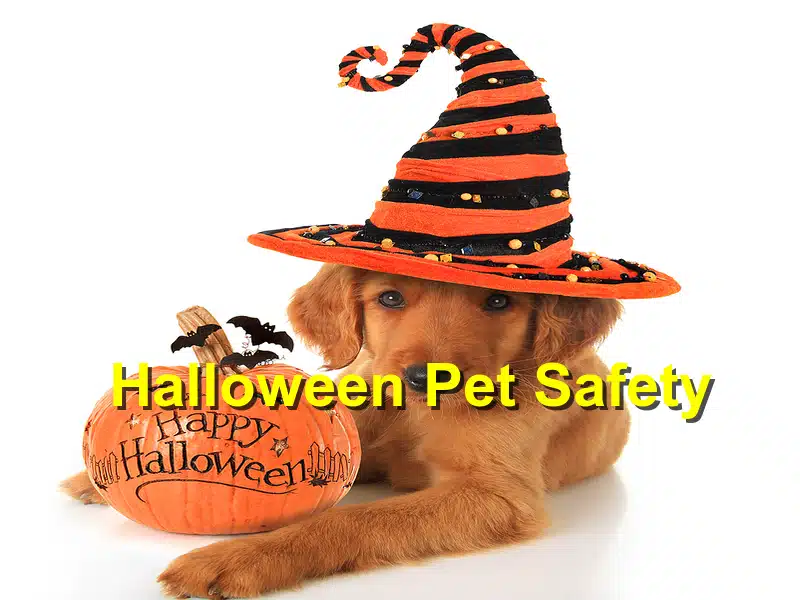Halloween is a fun time for families, but it can be stressful and dangerous for pets. With doorbells ringing, strangers in costumes, and candy everywhere, it’s easy for pets to get overwhelmed. Taking the proper precautions will help ensure your pet stays safe and calm during the festivities. Here are some essential Halloween pet safety tips to prevent frightening accidents.
1. Costume Safety for Pets
Dressing up pets in costumes is a popular Halloween tradition, but it’s important to prioritize their safety and comfort. Not all pets enjoy wearing costumes, and some may feel restricted or stressed by unfamiliar clothing.
- Choose Comfortable, Well-Fitting Costumes: If you dress your pet up, make sure the costume fits properly and does not restrict their movement, vision, or breathing. Avoid costumes with small, loose parts that could become a choking hazard.
- Test the Costume in Advance: Let your pet wear the costume a few times before Halloween to ensure they are comfortable. If they seem distressed or anxious, skip the costume altogether.
- Monitor for Signs of Discomfort: Keep an eye on your pet’s behavior while they are in costume. If they appear stressed, uncomfortable, or agitated, remove the costume immediately.
2. Keep Pets Away from Halloween Treats
Halloween candy can be harmful or even toxic to pets, particularly chocolate and sugar-free candies that contain xylitol. Dogs and cats have a heightened sense of smell, so keeping sweets out of their reach is crucial.
- No Candy for Pets: Chocolate and xylitol, commonly found in gum and candy, can be toxic to both dogs and cats. Even small amounts can cause vomiting, seizures, and more serious health issues.
- Store Candy Safely: Keep all candy and treats in high, closed cabinets or containers where pets cannot access them. If you have young children, remind them that sharing their candy with pets is dangerous.
- Know the Signs of Poisoning: If your pet accidentally consumes candy, watch for symptoms such as vomiting, diarrhea, rapid breathing, and lethargy. In these cases, contact your vet immediately.
3. Manage Trick-or-Treaters and Doorbell Anxiety
Constant doorbell ringing and strangers in costumes can be overwhelming for pets, especially those who are anxious or territorial. Managing how your pet interacts with trick-or-treaters can help prevent accidents.
- Create a Safe Space: Set up a quiet, comfortable room where your pet can retreat if they become anxious from the doorbell or visitors. Provide toys, a blanket, and maybe some soothing background music to help them relax.
- Use Pet Gates or Leashes: If your pet is prone to darting out the door, use a pet gate or keep them on a leash when opening the door for trick-or-treaters. This can prevent them from running into the street or getting lost.
- Limit Interaction: Some pets may become frightened or aggressive around strangers in costumes. To avoid potential incidents, limit your pet’s interaction with trick-or-treaters or keep them secured in another part of the house.
4. Halloween Decorations and Hazards
While festive decorations are a fun part of Halloween, they can pose risks to curious pets. Certain types of décor, such as candles, strings of lights, and small, ingestible decorations, can lead to accidents.
- Be Mindful of Fire Hazards: If you use candles, particularly in pumpkins, make sure they are placed out of your pet’s reach. Pets can easily knock over candles, potentially causing burns or fires.
- Keep Small Decorations Out of Reach: Some pets, especially puppies or kittens, may chew on small decorations. Be sure to keep strings of lights, fake spider webs, and small, plastic items away from your pet, as they could cause choking or intestinal blockages.
- Avoid Toxic Plants: Some popular fall plants, like pumpkins and decorative corn, can upset your pet’s stomach if ingested. Make sure any decorative plants are placed out of reach.
5. Trick-or-Treating with Pets: Proceed with Caution
If you plan to take your pet trick-or-treating with the family, there are several precautions to consider to ensure their safety.
- Use Reflective Gear: If your pet joins you for trick-or-treating, make sure they wear a reflective collar, leash, or vest to make them visible in the dark. You might also consider adding an LED tag to their collar for extra visibility.
- Stay Calm and Aware: Trick-or-treating can be overwhelming for pets due to the noise, crowds, and unfamiliar surroundings. Keep a close eye on your pet and monitor their stress levels. If they seem anxious, it’s best to take them home early.
- Keep Them Leashed: Always keep your pet on a leash while trick-or-treating to prevent them from running off. Even well-trained pets can get spooked by loud noises or unfamiliar sights, so it’s best to play it safe.
6. Microchip and ID Tags
One of the scariest Halloween risks for pets is the possibility of them getting lost. With all the activity, it’s easy for pets to slip out unnoticed.
- Ensure Your Pet’s ID Tags Are Up-to-Date: Before Halloween, check that your pet’s ID tags have accurate contact information. If they don’t have ID tags, consider getting them one.
- Consider Microchipping: Microchipping your pet is a permanent way to ensure they can be identified if they get lost. Make sure your pet’s microchip information is up to date with your current contact details.
Conclusion
Halloween can be a fun and exciting holiday for the whole family, but it’s important to take extra precautions to keep your pets safe. From costume safety to keeping them calm around trick-or-treaters, a little planning can prevent frightening accidents. With the right care and attention, your pets can enjoy a safe and stress-free Halloween.
References: Pawlicy, PetInsurance




